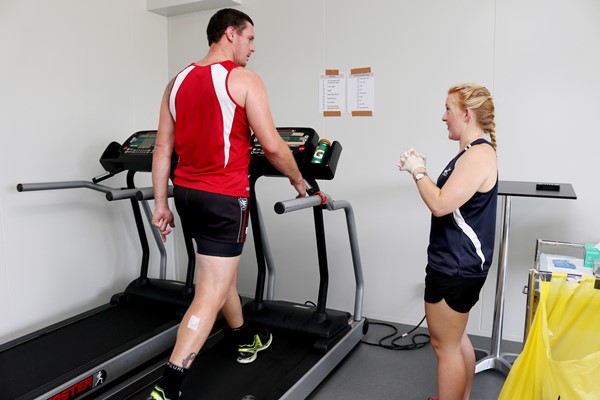Marcus Butler
27 March 2016: Whether training in hot conditions can improve athletes’ performance on game day is the focus of a study undertaken at the University of Canberra.
Dr Naroa Etxebarria, assistant professor of sport and exercise science at the University’s Research Institute for Sport and Exercise (UCRISE), senior physiologist and Professor David Pyne from the Australian Institute of Sport and PhD candidate Rachel Gale (UCRISE/AIS) are working with Canberra’s Ainslie Football Club to put their hypothesis to the test.
Dr Etxebarria said that, in theory, when an athlete trains under the additional stress of a heated environment, their body adapts, so when competing in normal temperatures, the athletes are should perform better.
“We tested the Ainslie players to establish their baseline performance level and during a separate test in UCRISE’s environmental chamber, the players also self-reported their thermal comfort levels,” Dr Etxebarria said.
“The players will complete six training sessions over two and a half weeks in the chamber, where they can exercise while we boost the temperature to about 35 degrees Celsius and 50 per cent humidity.”
“We are comparing their core body and skin temperature, heart rate, blood lactate levels, how hot they are feeling and the exertion they use to complete the exercise at the start and then again after their training program,” she said.
The participants from the Ainslie Football Club resume their normal pre-season training schedule prior to the start of the 2016 AFL Canberra season next month.
PhD candidate Rachel Gale says she’s keen to see if the heat training results will give sportspeople a boost to their performance in thermo-neutral environments.
“The way in which the body adapts to the heat training is really quiet impressive,” Ms Gale said.
“Within a few days, the adaptions we start seeing include a reduction in core body temperature and heart rate, improved cardiovascular function and earlier onset of sweat at lower core body temperatures, among other changes.
“For those of us who aren’t elite athletes, the research may encourage people to train in the warm summer weather as a boost to their exercise, with proper preparation of course.”
When exercising in heat, it is advised to ensure good hydration at least an hour before exercise and to then introduce heat gradually.



